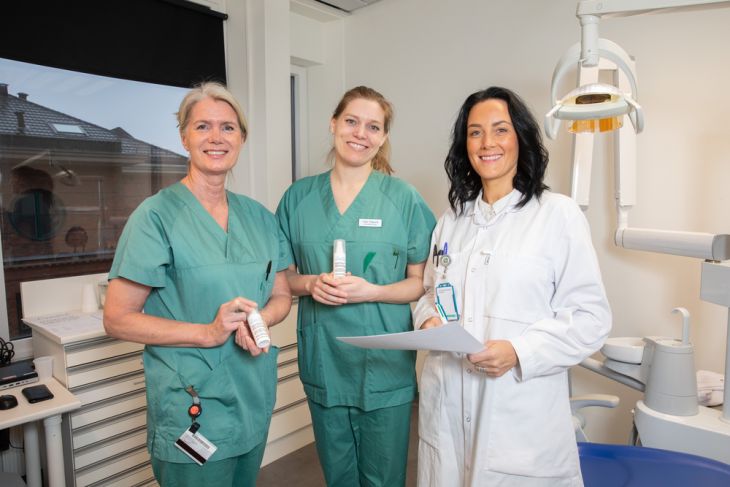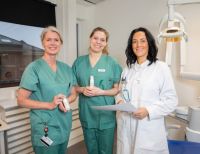At the Research Clinic, there is hectic activity. Recently, a clinical trial of the product Liposal started, investigating whether it can relieve dry mouth. The pilot study conducted by Janicke Liaaen Jensen and Julie Frigaard aims to test the product on 20 patients who have challenges with dry mouth.
Julie Frigaard is a PhD candidate, and a part of her work for her thesis was a prelude to testing this product. In collaboration with Marianne Hiorth at the Department of Pharmacy, they developed the mouth spray Liposal, which contains polymer-coated liposomes (liposomes are small spherical particles in the nanometer range). The product was developed and produced in Hiorth's lab at the Department of Pharmacy.
– We received financial support from the innovation program SPARK, Julie became a "SPARKee," and we were allocated one million kroner from them for this project, as well as 500,000 kroner from the Norwegian Research Council. Without these funds, it would have been impossible to carry out the trial, says Janicke.
– In the lab, we have tested different ingredients and concentrations in the mouth spray. We have looked at what stays stable, as the product needs to have a certain durability. Additionally, it must not be toxic. It has been an important task for me to test the ingredients on living cells to see if there is anything dangerous or harmful to them, Julie explains.
Liposal was partly produced in Marianne's lab, and partly in the Laboratory of Hilde Galtung at the Institute of Oral Biology, who is also a collaborator.
Liposal or placebo?
– Now, there is a clinical trial of Liposal, and it is a milestone that we have come this far, emphasizes Janicke Liaaen Jensen. It is a pilot study, and humans test the product for the first time.
– A lot of the funding for the project has been spent on getting help with writing applications, so we have obtained approval from the Regional Committees for Medical and Health Research Ethics, SIKT (the knowledge sector's service provider), and the Directorate for Medical Products. It is a big bureaucratic process to go through, and it took us many months and delayed the project because the approval process was so thorough.
As far as she knows, no one at the Faculty of Dentistry has been involved in developing a product that has come this far to be tested as a medical aid in a double-blinded prospective study.
– We have been able to do this now because Marianne Hiorth and her coworkers have researched the special polymer-coated liposomes for several years. After we got in touch with her, we developed the product together and adapted it for clinical use in dry-mouth patients. This special product is supposed to attach to the oral mucosa and slowly release fluid so that it hopefully has a more long-lasting effect than the other products on the market.
– Liposal is produced in Marianne Hiorth's lab at the Department of Pharmacy. They have done a big job producing it and preparing and approving it before the trial. Marianne Hiorth's lab has "blinded" it, so only Marianne knows what the bottles contain, whether it is Liposal in the mouth spray or a placebo. Therefore, Marianne cannot be present during the trial on the patients.
Can you patent the product and put it into production?
– No, unfortunately, we cannot, says Janicke.
– Marianne has already published several studies with polymer-coated liposomes, so the recipe is based on secrecy. For that reason, we cannot say what the product contains.
 Liposal, the mouth spray or placebo. Photo: Marie Lindeman Johansen. Photo: Marie Lindeman Johansen, OD/UiO
Liposal, the mouth spray or placebo. Photo: Marie Lindeman Johansen. Photo: Marie Lindeman Johansen, OD/UiO
Resource-intensive product testing
– The project required a research nurse to be present to ensure patient follow-up, so we have allocated funds for that purpose. Carina Athelie Skredlund is a research nurse and she is employed by Smerud Medical Research. They serve as the monitor in the study, and a colleague from Smerud checks the data, takes over the data, and ultimately writes a report for us, says Janicke.
– Smeruds’ role as a monitor is to ensure that we perform the trial correctly, including patient safety and submissions to authorities. Our primary focus is to ensure that we follow the protocol, Carina explains.
– The most important thing we do is to ensure that I have executed my responsibilities correctly, as well as ensure that Janicke and Julie have done the same.
Extensive documentation
– We can show you the protocol that Smerud Medical Research follows, Janicke says.
She retrieves two thick binders containing all the necessary paperwork.
– We are conducting a trial involving 20 individuals, each of whom will visit us three times. Including patients in the study has posed some challenges due to winter weather, slippery conditions, and the presence of influenza, COVID-19, and RSV. Our goal is to complete the study before Easter, Janicke adds.
– Julie and I collaborate in examining the patients, Janicke explains.
– We complete the forms and journal in Opus. When the patients are with us, we ensure they meet the inclusion criteria for participating in the study, including adequate dryness of the mouth and low saliva secretion.
– There is a substantial amount of paperwork involved. We must document all the patients' illnesses and their onset, as well as all the medications they use and when they began using them. We need to know the dosage, and reasons for use. Thus, there is a comprehensive mapping and documentation of the participating patients, Janicke details.
– Following our review of the patient, research nurse Carina takes charge and guides them on how to use the spray and how to fill out the diary together. The diary contains several questions about the product's usage and effect throughout the day and night.
 Julie and Janicke in the Research Clinic. Photo: Marie Lindeman Johansen, OD/UiO
Julie and Janicke in the Research Clinic. Photo: Marie Lindeman Johansen, OD/UiO
Anticipation of the results
– The patient is required to spray the contents of the bottle into their mouth three times, and then they record their perceptions of the spray. They repeat this every fifteen minutes until the spray no longer has an effect. Some participants left after fifteen minutes, while others stayed for two hours. Therefore, we hope that those who have stayed for two hours have used Liposal, Janicke comments.
– The participants then take the product home for a week and are required to keep a diary, both in the morning and evening. They must answer several questions about the product's performance. They will maintain a diary for two products and, ultimately, compare and share which they prefer. The most thrilling answer for us is how the participants feel about the product's performance, Janicke expresses.
– Once all the data is collected, Smerud's statistician takes charge and summarizes the findings in a report. This will determine if the product's effects are significant enough to proceed with a larger study, which would examine long-term effects, and side effects, and include additional patient groups. However, if patients express no preference, we will not proceed with this product. Therefore, we are eagerly awaiting the results.
Homogeneous patient group
– We are already familiar with the patient group that is currently testing Liposal. They are individuals with Sjögren's syndrome or those who have been evaluated for Sjögren's syndrome and have previously participated in studies, says Janicke.
– Many patients we have approached have willingly agreed to participate and are eager to contribute to the trial, adds Carina.
She is the one who contacted them to inquire about their interest in participating.
– Participants do not have to have a confirmed diagnosis of Sjögren's syndrome, but they should have undergone evaluation for it, states Janicke.
– They should exhibit symptoms such as dry mouth, dry eyes, reduced tear production, and diminished saliva. Sjögren's syndrome patients typically have positive blood tests for autoantibodies, positive salivary gland biopsies, or both.
– Non-Sjögren's patients do not exhibit positive blood tests or salivary gland biopsies, but they experience the same symptoms as Sjögren's patients. These patients also require this product. We have intentionally chosen these patient groups to create a fairly uniform selection. We could also include patients who have undergone radiation therapy for head and neck cancer or patients with dry mouths caused by medication. If this product proves to be as effective as we hope, these patients will also be included in a larger study. We need evidence of its effectiveness across multiple patient groups for it to be considered for further development, concludes Janicke.














